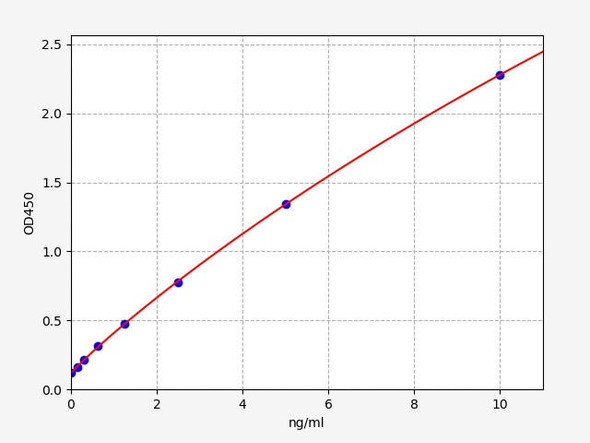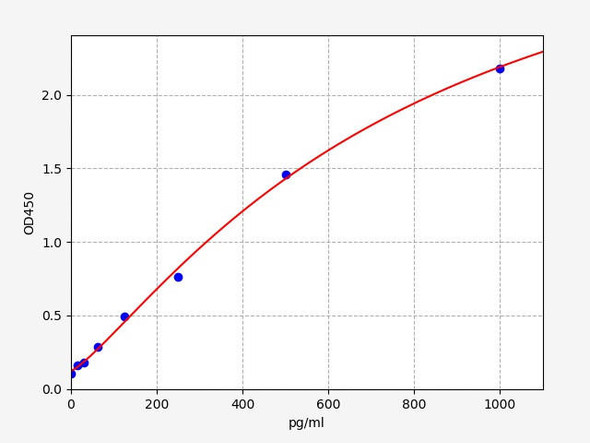Human Immunology ELISA Kits 1
Human CLDN1 (Claudin 1) CLIA Kit (HUES00469)
- SKU:
- HUES00469
- Product Type:
- ELISA Kit
- ELISA Type:
- CLIA Kit
- Size:
- 96 Assays
- Sensitivity:
- 18.75pg/mL
- Range:
- 31.25-2000pg/mL
- ELISA Type:
- Sandwich
- Reactivity:
- Human
- Sample Type:
- Serum, plasma and other biological fluids
- Research Area:
- Immunology
Description
| Assay type: | Sandwich |
| Format: | 96T |
| Assay time: | 4.5h |
| Reactivity: | Human |
| Detection method: | Chemiluminescence |
| Detection range: | 31.25-2000 pg/mL |
| Sensitivity: | 18.75 pg/mL |
| Sample volume: | 100µL |
| Sample type: | Serum, plasma and other biological fluids |
| Repeatability: | CV < 15% |
| Specificity: | This kit recognizes Human CLDN1 in samples. No significant cross-reactivity or interference between Human CLDN1 and analogues was observed. |
This kit uses Sandwich-CLIA as the method. The micro CLIA plate provided in this kit has been pre-coated with an antibody specific to Human CLDN1. Standards or samples are added to the appropriate micro CLIA plate wells and combined with the specific antibody. Then a biotinylated detection antibody specific for Human CLDN1 and Avidin-Horseradish Peroxidase (HRP) conjugate are added to each micro plate well successively and incubated. Free components are washed away. The substrate solution is added to each well. Only those wells that contain Human CLDN1, biotinylated detection antibody and Avidin-HRP conjugate will appear fluorescence. The Relative light unit (RLU) value is measured spectrophotometrically by the Chemiluminescence immunoassay analyzer. The RLU value is positively associated with the concentration of Human CLDN1. The concentration of Human CLDN1 in the samples can be calculated by comparing the RLU of the samples to the standard curve.
| UniProt Protein Function: | Claudin-1: Plays a major role in tight junction-specific obliteration of the intercellular space, through calcium- independent cell-adhesion activity. Acts as a co- receptor for HCV entry into hepatic cells. Can form homo- and heteropolymers with other CLDN. Homopolymers interact with CLDN3, but not CLDN2, homopolymers. Directly interacts with TJP1/ZO-1, TJP2/ZO-2 and TJP3/ZO-3. Interacts with MPDZ and INADL. May interact with HCV E1 and E2 proteins. Strongly expressed in liver and kidney. Expressed in heart, brain, spleen, lung and testis. Belongs to the claudin family. |
| UniProt Protein Details: | Protein type:Membrane protein, integral; Cytoskeletal; Membrane protein, multi-pass Chromosomal Location of Human Ortholog: 3q28-q29 Cellular Component: integral to membrane; integral to plasma membrane; tight junction Molecular Function:identical protein binding; protein binding Biological Process: calcium-independent cell-cell adhesion; intercellular junction assembly and maintenance; protein heterooligomerization; protein homooligomerization Disease: Ichthyosis, Leukocyte Vacuoles, Alopecia, And Sclerosing Cholangitis |
| NCBI Summary: | Tight junctions represent one mode of cell-to-cell adhesion in epithelial or endothelial cell sheets, forming continuous seals around cells and serving as a physical barrier to prevent solutes and water from passing freely through the paracellular space. These junctions are comprised of sets of continuous networking strands in the outwardly facing cytoplasmic leaflet, with complementary grooves in the inwardly facing extracytoplasmic leaflet. The protein encoded by this gene, a member of the claudin family, is an integral membrane protein and a component of tight junction strands. Loss of function mutations result in neonatal ichthyosis-sclerosing cholangitis syndrome. [provided by RefSeq, Jul 2008] |
| UniProt Code: | O95832 |
| NCBI GenInfo Identifier: | 6685283 |
| NCBI Gene ID: | 9076 |
| NCBI Accession: | O95832. 1 |
| UniProt Related Accession: | O95832 |
| Molecular Weight: | 22,744 Da |
| NCBI Full Name: | Claudin-1 |
| NCBI Synonym Full Names: | claudin 1 |
| NCBI Official Symbol: | CLDN1 |
| NCBI Official Synonym Symbols: | CLD1; SEMP1; ILVASC |
| NCBI Protein Information: | claudin-1 |
| UniProt Protein Name: | Claudin-1 |
| UniProt Synonym Protein Names: | Senescence-associated epithelial membrane protein |
| Protein Family: | Claudin |
| UniProt Gene Name: | CLDN1 |
| UniProt Entry Name: | CLD1_HUMAN |
As the RLU values of the standard curve may vary according to the conditions of the actual assay performance (e. g. operator, pipetting technique, washing technique or temperature effects), the operator should establish a standard curve for each test. Typical standard curve and data is provided below for reference only.
| Concentration (pg/mL) | RLU | Average | Corrected |
| 2000 | 50359 61083 | 55721 | 55693 |
| 1000 | 23625 24323 | 23974 | 23946 |
| 500 | 11350 10714 | 11032 | 11004 |
| 250 | 5044 5544 | 5294 | 5266 |
| 125 | 2811 2405 | 2608 | 2580 |
| 62.5 | 1335 1287 | 1311 | 1283 |
| 31.25 | 631 717 | 674 | 646 |
| 0 | 27 29 | 28 | -- |
Precision
Intra-assay Precision (Precision within an assay): 3 samples with low, mid range and high level Human CLDN1 were tested 20 times on one plate, respectively.
Inter-assay Precision (Precision between assays): 3 samples with low, mid range and high level Human CLDN1 were tested on 3 different plates, 20 replicates in each plate.
| Intra-assay Precision | Inter-assay Precision | |||||
| Sample | 1 | 2 | 3 | 1 | 2 | 3 |
| n | 20 | 20 | 20 | 20 | 20 | 20 |
| Mean (pg/mL) | 100.24 | 311.52 | 795.72 | 92.50 | 327.00 | 852.76 |
| Standard deviation | 10.53 | 27.07 | 77.50 | 11.73 | 38.88 | 57.13 |
| C V (%) | 10.50 | 8.69 | 9.74 | 12.68 | 11.89 | 6.70 |
Recovery
The recovery of Human CLDN1 spiked at three different levels in samples throughout the range of the assay was evaluated in various matrices.
| Sample Type | Range (%) | Average Recovery (%) |
| Serum (n=5) | 84-100 | 91 |
| EDTA plasma (n=5) | 97-108 | 103 |
| Cell culture media (n=5) | 96-111 | 102 |
Linearity
Samples were spiked with high concentrations of Human CLDN1 and diluted with Reference Standard & Sample Diluent to produce samples with values within the range of the assay.
| Serum (n=5) | EDTA plasma (n=5) | Cell culture media (n=5) | ||
| 1:2 | Range (%) | 100-114 | 91-105 | 94-108 |
| Average (%) | 107 | 96 | 100 | |
| 1:4 | Range (%) | 85-98 | 92-109 | 93-108 |
| Average (%) | 92 | 100 | 100 | |
| 1:8 | Range (%) | 95-107 | 88-101 | 98-111 |
| Average (%) | 102 | 94 | 105 | |
| 1:16 | Range (%) | 99-116 | 91-102 | 95-110 |
| Average (%) | 106 | 96 | 103 |
An unopened kit can be stored at 4°C for 1 month. If the kit is not used within 1 month, store the items separately according to the following conditions once the kit is received.
| Item | Specifications | Storage |
| Micro CLIA Plate(Dismountable) | 8 wells ×12 strips | -20°C, 6 months |
| Reference Standard | 2 vials | |
| Concentrated Biotinylated Detection Ab (100×) | 1 vial, 120 µL | |
| Concentrated HRP Conjugate (100×) | 1 vial, 120 µL | -20°C(shading light), 6 months |
| Reference Standard & Sample Diluent | 1 vial, 20 mL | 4°C, 6 months |
| Biotinylated Detection Ab Diluent | 1 vial, 14 mL | |
| HRP Conjugate Diluent | 1 vial, 14 mL | |
| Concentrated Wash Buffer (25×) | 1 vial, 30 mL | |
| Substrate Reagent A | 1 vial, 5 mL | 4°C (shading light) |
| Substrate Reagent B | 1 vial, 5 mL | 4°C (shading light) |
| Plate Sealer | 5 pieces | |
| Product Description | 1 copy | |
| Certificate of Analysis | 1 copy |
- Set standard, test sample and control (zero) wells on the pre-coated plate and record theirpositions. It is recommended to measure each standard and sample in duplicate. Note: addall solutions to the bottom of the plate wells while avoiding contact with the well walls. Ensuresolutions do not foam when adding to the wells.
- Aliquot 100µl of standard solutions into the standard wells.
- Add 100µl of Sample / Standard dilution buffer into the control (zero) well.
- Add 100µl of properly diluted sample (serum, plasma, tissue homogenates and otherbiological fluids. ) into test sample wells.
- Cover the plate with the sealer provided in the kit and incubate for 90 min at 37°C.
- Aspirate the liquid from each well, do not wash. Immediately add 100µL of BiotinylatedDetection Ab working solution to each well. Cover the plate with a plate seal and gently mix. Incubate for 1 hour at 37°C.
- Aspirate or decant the solution from the plate and add 350µL of wash buffer to each welland incubate for 1-2 minutes at room temperature. Aspirate the solution from each well andclap the plate on absorbent filter paper to dry. Repeat this process 3 times. Note: a microplatewasher can be used in this step and other wash steps.
- Add 100µL of HRP Conjugate working solution to each well. Cover with a plate seal andincubate for 30 min at 37°C.
- Aspirate or decant the solution from each well. Repeat the wash process for five times asconducted in step 7.
- Add 100µL of Substrate mixture solution to each well. Cover with a new plate seal andincubate for no more than 5 min at 37°C. Protect the plate from light.
- Determine the RLU value of each well immediately.






